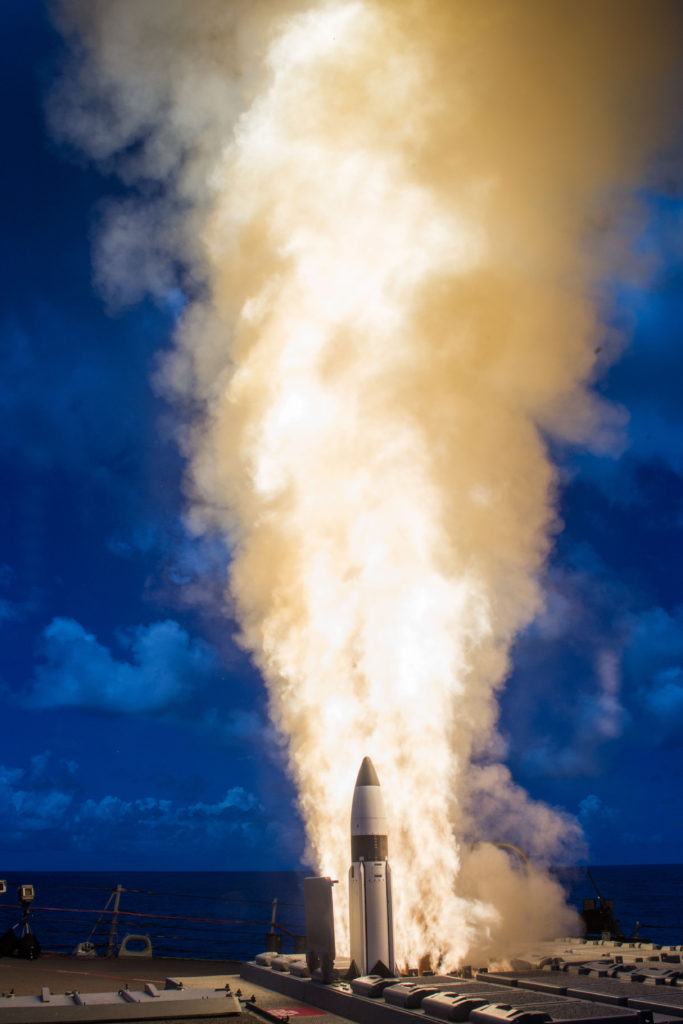Dear Members and Friends,
Over the past two weeks concluding yesterday, leveraging the existing missile defense capabilities out of PMRF testing range in Kauai, Hawaii with a baseline 9 Aegis BMD Destroyer, the USS John Paul Jones and an Aegis BMD Destroyer, the USS Hopper, the United States Navy and the Missile Defense Agency have reduced risk, increased reliability to track, discriminate and defeat the most sophisticated ballistic missile threats in the world today.
The Chinese DF-21D is a road mobile, medium range, anti-ship, nuclear capable ballistic missile with maneuverable capabilities in space and in reentry that is currently deployed by the Chinese and designed to sink U.S. Aircraft Carriers. Click here to watch state-released footage from China of a test of the DF-21D.
Last week on May 17, a new medium target missile was flown for the first time, launching out of the PMRF range in Hawaii. Tracking and discriminating that target were three current sensors that are deployed around the world by the United States for Missile and Air Defense missions. The SPY radar on the floating Aegis BMD baseline 9 Ship, the USS John Paul Jones (DDG-53), the SPY radar on the baseline 9 Aegis Ashore Site on land at PMRF in Kauai and the TYP-2 Radar on land at PMRF in Kauai. These three tracking, discriminating and targeting sensors in operations around the world today combined with SM-6 interceptors that are carried on U.S. Aegis Ships that are easily adapted to Aegis Ashore platforms have the capability to defeat maneuverable ballistic and reentry warheads. Click here for MDA’s press release of the May 17 test. Click here for a video of the target missile used during that test. Click here to view an overview of the test.
Concluding yesterday out of PMRF in Hawaii was the second successful fly-out of the SM-3 Block IB interceptor this week from the USS Hopper (DDG-70) that validated adjustments to the third stage rocket motor and staging for increased reliability for the entire SM-3 fleet. Click here for MDA’s press release on the test. This validation of these adjustments will now enable full-rate production of the SM-3 Block IB interceptor. With an 80% successful intercept rate reflecting 28 intercepts out of 35 targets, there was not a need for intercepts on these two tests as the reliability issues were in the staging prior to intercept. This efficiency and good stewardship of government dollars is to be commended, as tens of millions of dollars were saved by not including target missiles in these flight tests.
 |
|
An SM-3 Block IB launched from the USS Hopper during MDA’s flight-tests on May 25 and 26. |
These 3 successful tests that spanned over two weeks have enhanced reliability and confidence of all the 250 plus total SM-3 interceptors deployed today on 33 U.S. Aegis BMD Ships, 4 Japanese Kongo Class BMD Ships and one Aegis Ashore Site in Romania, enabling full-rate production of the SM-3 IB interceptors for an additional 250 plus interceptors to the fleet by 2020. By 2020, the United States plans to have 39 total deployed U.S. Aegis BMD-capable ships and two Aegis Ashore platforms in Romania and Poland that would all be outfitted with SM-3 IB interceptors. Adding to these current 41 platforms for SM-3 Interceptors is Japan as it plans to increase to 6 BMD destroyers by upgrading two Atago Class destroyers by 2020.
It is shocking and remains without legitimate reason or concern of Hawaii and its 1.4 million U.S. Citizens in defense from the current North Korean ballistic missile threat, that PMRF in Kauai, Hawaii with the very best missile defense assets in the world that are being tested and validated against the most sophisticated ballistic missile threats in the world today is not operational to defend Hawaii in emergency situations.
